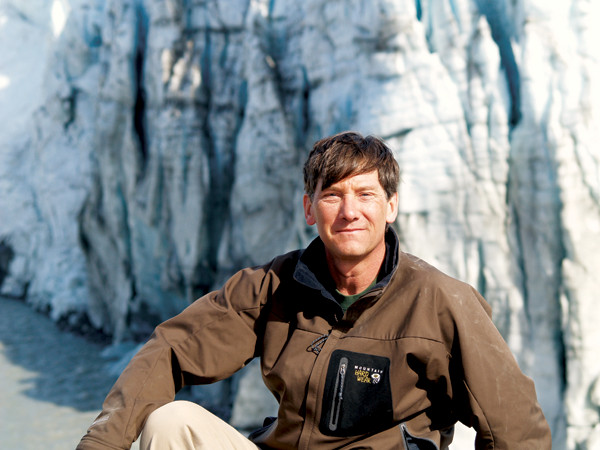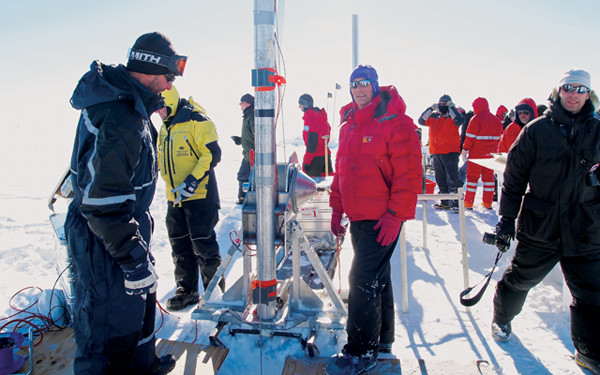
by Terri Cook Wednesday, December 17, 2014

James White is director of the Institute of Arctic and Alpine Research at the University of Colorado in Boulder. Credit: Courtesy of James White.
James White contends that he has one claim to fame: He grew up just 50 kilometers from Dolly Parton in eastern Tennessee. His father worked as a chemist at Oak Ridge National Laboratory, an enclave of science west of Knoxville. Now a chemist himself, White actually has more claims to fame than he is willing to admit. He has co-authored more than 100 peer-reviewed scientific publications; he is the director of the University of Colorado’s Institute of Arctic and Alpine Research (INSTAAR); and he has been named an Institute for Scientific Information highly cited scientist — an honor bestowed on less than 0.5 percent of all publishing researchers. White recently spoke with EARTH contributor Terri Cook about how he nearly became an oceanographer, the importance of interdisciplinary education and research, and how Superstorm Sandy could affect the public perception of climate change.
TC: How did you decide what school to attend as an undergraduate?
JW: In high school, I had to write a paper on what I wanted to be in my life. I found a book on oceanography in the library, and when I read this book, I thought it was cool and that maybe I should be an oceanographer. So, when it came time to apply to college, I wanted to find a university where I could pursue this desire.
At the time, my grades were not stellar. I was the second child, and I didn’t apply myself terribly well in high school. Later I learned my dad was convinced that I wouldn’t finish college, so he didn’t want to pay for an expensive university. I applied to Florida State and Texas A&M, both of which had oceanography programs. But, as was my wont at the time, I didn’t do my homework and didn’t find out that you couldn’t major in oceanography as an undergraduate at either school. When I got in to both colleges, Texas A&M sent me a hatband and literature explaining that every freshman there was in ROTC. This was during the Vietnam War. My draft number was 101 — right on the borderline. So, I decided to be a Seminole.
TC: What led you to study chemistry?
JW: I took chemistry at 8 a.m. my first semester. I am not a morning person by any stretch of the imagination, but I loved going to that class. I was in a quandary because my dad’s an analytical chemist, and the last thing I wanted to be was a chemist — it was that second-child rebellious nature. When I became a chemistry major in my sophomore year, I didn’t tell him. But he figured it out when he saw that I was taking physical chemistry. No one takes that class unless you’re a chemist or you’re crazy, one of the two.
Somewhere along the line I also figured out that I couldn’t major in oceanography, but I did take a few classes. It was slowly dawning on me that what I was really interested in studying was the planet — in particular, how chemistry is applied to planetary functions like the carbon and the nitrogen cycles.
When I applied to graduate schools, I still wanted the possibility of studying oceanography. I was very much taken by Wally Broecker, who invited me to be his graduate student at Columbia. Wally had five new students that year. He lined us up in the hallway and gave us thesis projects. … I was last alphabetically. The guy in front of me got this wonderful project using corals to study ocean currents and carbon cycling in the ocean. The project I got was [measuring] stable isotopes in tree rings. So, I missed oceanography as an undergraduate, and then I missed it again — though not by much — as a graduate student.
TC: When did you transition from studying tree rings to ice cores?
JW: I realized toward the end of my thesis that stable isotopes in tree rings was not where I wanted to place my efforts. I had hit it off with Jean Jouzel, a scientist visiting from France. He was putting isotopes from the water cycle into a general circulation model at NASA-Goddard Institute for Space Studies in New York. When Jean went back to France, he invited me to do a post-doc with him.
At that time the French were working with the Russians to finish the analysis of the Vostok [Antarctica] ice core, and their manuscript included the isotopic and carbon dioxide records, key pieces of information that have changed our understanding of paleoclimate. Scientists were just beginning to understand this relationship when I started to work with Jouzel on ice cores in the mid-1980s.
Then I met Willi Dansgaard and Sigfus Johnsen, and the three of us began looking at abrupt climate change on a year-by-year basis. That was another moment when I was in the right place at the right time. We wrote one of the first papers showing that climate can change by enormous amounts in less than a human lifetime. Abrupt climate change has been part of my research ever since.

White drilling ice cores in Antarctica. Credit: Courtesy of James White.
TC: Why have you focused your career on climate change?
JW: I chose the two areas that I wanted to study — climate change and the carbon cycle — late in my graduate career. I thought those were two problems of societal importance that we needed to research. I liked the idea that the science I was doing was going to be important to people. But I also thought that we’d be doing something about fossil fuel burning long before now. Boy, was I wrong!
TC: Why do you take an interdisciplinary approach to research?
JW: When I came here [to CU], I realized that the only way to study the Earth and have it really make sense was to include not only the physics and chemistry of the planet, but also the primary agent of change, human beings. Back in the early 1990s, people would write papers about what the climate is going to look like in 200 years, and they didn’t include any humans. That’s when I knew that we had to change not only the way we were researching this problem, but our educational system as well.
I also learned that the interdisciplinary approach I had taken was not the way the rest of the world worked, particularly in higher education. I’ve always found it ironic because all of us, regardless of the field we work in, challenge the reigning ideas and paradigms. But when it comes to education, the world is carved up into disciplines, and many people don’t want to entertain the idea of rearranging.
TC: A recent poll conducted by the Yale Project on Climate Change Communication found that the proportion of Americans who believe climate change is caused by humans has dropped from 50 to 46 percent. Why do you think this is the case?
JW: I don’t think anybody wants to face big problems. I remember a fascinating study I read 20 years ago about people living in California. Researchers asked them how close they live to an earthquake fault. The average response was around 20 miles, when the actual number was more like two miles. When they broke the results down, it didn’t matter how well educated people were. A Ph.D. was just as capable of denying the obvious as someone who had not graduated from high school.
TC: Do you think Superstorm Sandy or other “strange weather” could change the way people think about climate change?
JW: These things … keep nudging us in the right direction; you keep chipping away, changing the way people think. I think a real game changer will come when we get leaders around the world who take a hard look at this situation and realize that we need to prepare for the future. I believe people are ready to understand the challenge of this generation, which is sustainability. But we’re going to need leaders to step forward and recognize that if we don’t do something about food supplies and freshwater and population, we’re going to have trouble. The earth is not infinite.
The difficult part is that because we live on a water planet, there’s always going to be a delay in the system, so that by the time we realize we’ve got a problem, we’ve got an irreversible problem. That’s hard for societies like ours with a very short-term view in political and economic systems. How do you make those time frames match?
TC: Do you think that scientists have an obligation to be environmentally responsible?
JW: I think it is important for individuals to do everything they can. However, until society as a whole gets serious about sustainability, the options we have are restricted. I take the advice of Edward Maibach [of George Mason University’s Center for Climate Change Communication]. I once asked him what’s the single most important thing that an individual can do, because I am asked that question all the time. He said it is who you elect. The most impact you can have is to talk to politicians, tell them that you are going to vote based on how you view an issue, such as climate change, and then vote that way.
© 2008-2021. All rights reserved. Any copying, redistribution or retransmission of any of the contents of this service without the expressed written permission of the American Geosciences Institute is expressly prohibited. Click here for all copyright requests.